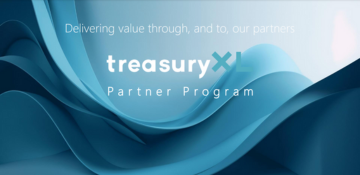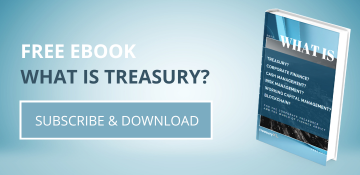FX-Risks Versus Technology
| 27-10-2017 | Treasurer Development | Minor Treasury @ Hogeschool Utrecht | Frans Boumans |
Today’s blog has been written by Daphne Piereij and Martijn Mullié, who are 2 students studying for the minor Treasury Management at the University of Applied Sciences in Utrecht. We welcome their contribution – it is good to see the youth engaging in Treasury matters! Here is their opinion on FX – risks versus technology.
“The one unchangeable certainty is that nothing is certain or unchangeable.” Those words were uttered by former US president John F Kennedy in a State of the Union address before Congress in 1962.
This still applies to the current state of the world. Especially within the financial markets and with FX Risks. Managing these risks have been completely revolutionized the past decades because of the new innovations in technology.
Traditionally traders manually update their volatility surfaces and bid-offer spreads, and that default pricing would have gone directly out to clients. More efficient is to use the electronic market data and automate much of that process, particularly in the most liquid currency pairs, creating a more transparent, data-driven practice.
According to McKinsey these are the trends in FX risk management with evolving technology and advanced analytics:
Big Data
Faster, cheaper computing power enables risk functions to use reams of structured and unstructured customer information to help them make better credit risk decisions.
In the future while this technology evolves and the quality of analytics of big data becomes better it will be easier to manage FX risks.
Machine Learning
This method improves the accuracy of risk models by identifying complex, nonlinear patterns in large data sets. Every bit of new information is used to increase the predictive power of the model.
Keeping in mind the words of former president John F. Kennedy the world will never be predictable and neither will the financial market. Because it’s not ran by machines but by humans, and humans are in general unpredictable. Which means this process has no end until the financial markets are managed by machines which are predictable.
Crowd Sourcing
The Internet enables the crowdsourcing of ideas, which many incumbent companies use to improve their effectiveness.
The internet can motivate people with challenges to work together to make algorithms for analytic functions so market data can be used more efficiently. It’s not always the most effective method to use the in-house developers to create algorithms. To make the most effective FX risk management algorithms is very hard and time consuming. Crowd Sourcing enables a whole different aspect to create algorithms, using more brains to create these immensely complicated methods to decrease FX risks.
Resources
https://www.mckinsey.com/business-functions/risk/our-insights/the-future-of-bank-risk-management
https://www.risk.net/risk-management/5276541/managing-fx-risk-how-to-prepare-for-the-unpredictable
Minor Treasury Management
More information about the minor Treasury Management at the University of Applied Sciences?
Please contact Frans Boumans.

Manager Minor Treasury Management @ University of Applied Sciences in Utrecht





 (1.5%, see diagram 5) by the chance it will be exercised (Delta, in this case 25%), ie 1.5% : 25% = 6%. It could be a very disappointing to find that if this Conditional Premium option is only marginally ITM at maturity, because the premium of 6% still has to be paid.
(1.5%, see diagram 5) by the chance it will be exercised (Delta, in this case 25%), ie 1.5% : 25% = 6%. It could be a very disappointing to find that if this Conditional Premium option is only marginally ITM at maturity, because the premium of 6% still has to be paid.
 bought the option for 1.5%, we could sell it after 3 months at 1.1% and buy the USD through an outright forward transaction. This approach shows that the net cost of option protection would be only 0.4% (1.5% – 1.1%). Which would be cheaper than the premium of a 3-month option with the same Delta. Also, because the option has a higher Delta than a 3-month option with the same strike (25% vs 10%, see diagram 2), it will follow the spot market much better. The bottom line of paragraph 3 is that a longer dated option can be bought with the intention to sell it again at some point, the net cost being less than buying a shorter dated option. While it serves as a hedge against price changes.
bought the option for 1.5%, we could sell it after 3 months at 1.1% and buy the USD through an outright forward transaction. This approach shows that the net cost of option protection would be only 0.4% (1.5% – 1.1%). Which would be cheaper than the premium of a 3-month option with the same Delta. Also, because the option has a higher Delta than a 3-month option with the same strike (25% vs 10%, see diagram 2), it will follow the spot market much better. The bottom line of paragraph 3 is that a longer dated option can be bought with the intention to sell it again at some point, the net cost being less than buying a shorter dated option. While it serves as a hedge against price changes. buy the 1-year option in diagram 2 for 1.5%. Alternatively we could consider buying a right to buy this option for 0.4% in 3 months time. At that time the 1-year option will only have 9 months remaining, but the strike and 1.5% premium are fixed in the contract. On the expiry date of the compound option we can decide if we want to pay 1.5% for the underlying option. Alternatively, assuming nothing has changed, we could buy a 9 month option in the market for 1.1% (see diagram 2). In such a case we wouldn’t exercise the compound option.
buy the 1-year option in diagram 2 for 1.5%. Alternatively we could consider buying a right to buy this option for 0.4% in 3 months time. At that time the 1-year option will only have 9 months remaining, but the strike and 1.5% premium are fixed in the contract. On the expiry date of the compound option we can decide if we want to pay 1.5% for the underlying option. Alternatively, assuming nothing has changed, we could buy a 9 month option in the market for 1.1% (see diagram 2). In such a case we wouldn’t exercise the compound option.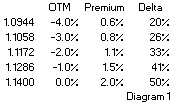 Should we need to exercise the option to get our USD, it still means a combined hedging cost of 3.8%. Which is more than if we had bought the ATM option for 2% premium. Conclusion: Buying an OTM option reduces the up-front cost versus buying an ATM option. But ex-post hedging with an OTM option could result in total hedging cost which are higher than an ATM option.
Should we need to exercise the option to get our USD, it still means a combined hedging cost of 3.8%. Which is more than if we had bought the ATM option for 2% premium. Conclusion: Buying an OTM option reduces the up-front cost versus buying an ATM option. But ex-post hedging with an OTM option could result in total hedging cost which are higher than an ATM option.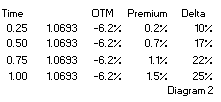 option is exercised, or the USD must be purchased from the market at the prevailing rate.
option is exercised, or the USD must be purchased from the market at the prevailing rate.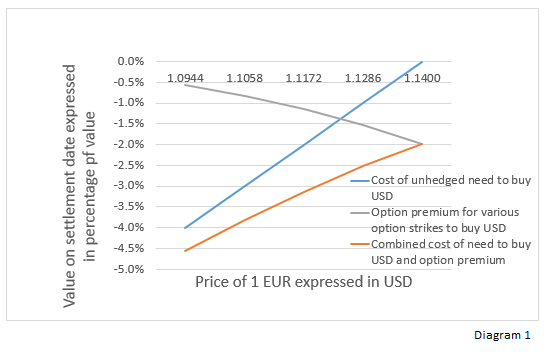
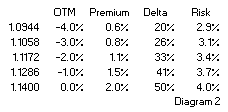 Risk appears fairly stabile across strikes, which makes sense because the premiums are calculated with one volatility on one underlying. The Risk on OTM is lower than that for ATM options. It appears that OTM premiums are relatively more expensive, they give protection against less potential loss.
Risk appears fairly stabile across strikes, which makes sense because the premiums are calculated with one volatility on one underlying. The Risk on OTM is lower than that for ATM options. It appears that OTM premiums are relatively more expensive, they give protection against less potential loss.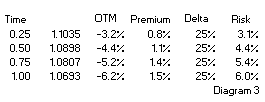 Diagram 3 shows Premiums, Delta and Risk for different tenors. ‘Time’ is the time to expiry of the options in fractions of years. Its shows that for longer tenors, the Risk is higher. But disproportionally. For the same chance on exercise a hedger could double the premium to buy a hedge for a 4x longer tenor.
Diagram 3 shows Premiums, Delta and Risk for different tenors. ‘Time’ is the time to expiry of the options in fractions of years. Its shows that for longer tenors, the Risk is higher. But disproportionally. For the same chance on exercise a hedger could double the premium to buy a hedge for a 4x longer tenor.